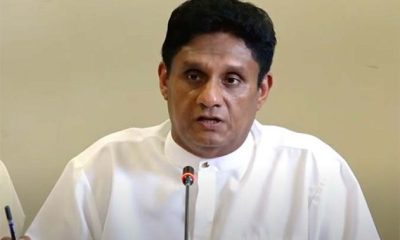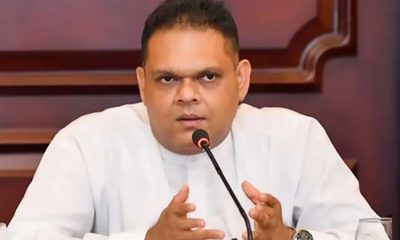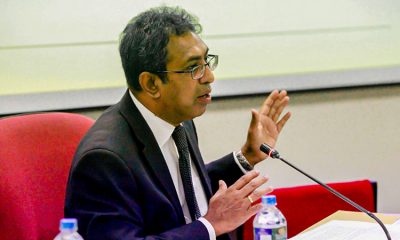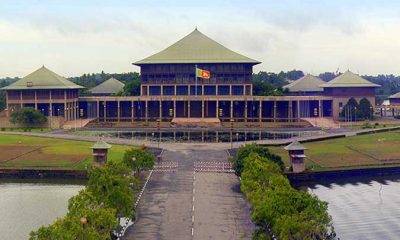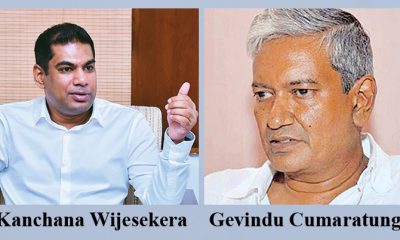Features
Five second escape for Prez and PM
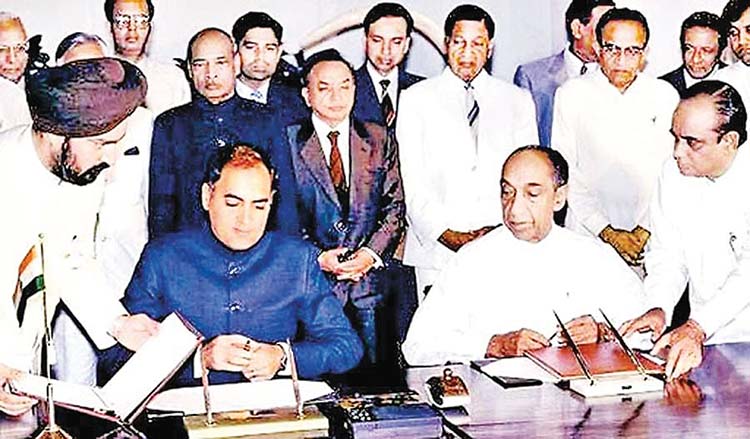
August 1987 parliament grenade attack
By Nihal Seneviratne
President J.R. Jayewardene had only a few days before, on July 29, 1987, signed the very controversial Indo- Sri Lanka Pact with Prime Minister Rajiv Gandhi of India. Most observers take the view that Jayewardene fighting a JVP insurrection in the South and a LTTE insurgency in the North had little option but to sign this agreement very much loaded on Indian terms.
The LTTE were determined to win a separate state of Eelam for the Tamil people even at the expense of a long, ferocious, war by spurning all Government efforts at coming to a peaceful solution offered to them. The JVP’s second insurgency had created a near anarchy in the South. There was no possibility of engaging in war on two fronts and Jayewardene signed the agreement which brought the IPKF here.
In signing this agreement, JRJ had not consulted his Prime Minister or his Cabinet colleagues. Possibly only Minister Gamini Dissanayake knew about it. After signing the agreement at Republic Square that day, Prime Minister Rajiv Gandhi was accorded a guard of honour. A naval rating who was part of the guard of honour assembled opposite President’s House, struck a heavy blow on Gandhi’s shoulder with the butt of his gun.
Very fortunately the PM was not seriously hurt but possibly suffered only a few bruises. Immediately his own Indian security and Sri Lankan naval security pushed the Indian PM forward to escape the severity of the blow and took the naval rating into custody. This single incident captured headlines all over the world. If the blow ended in the death of the Indian Prime Minister, the consequences would have been even too terrible to comprehend.
It was just two days later that President Jayewardene was due to attend a session of Parliament as he wished before that to address his own UNP Parliamentary Group in Committee Room 1 to explain to the Members why he signed the Agreement. Parliament was scheduled to sit the same afternoon for its regular business – President Jayewardene had arrived at the Parliamentary premises that morning around 9 a.m. and was due at Committee Room 1, the longest committee room in Parliament with a seating capacity of almost 150.
But since it was the Head of State and Government summoning me, I felt obliged to go. Both President Jayewardene and Prime Minister Premadasa were seated at the polished table with Premadasa on the President’s right and Chief Government Whip Vincent Perera on his left. In front over 100 Govt Ministers and MPs were seated facing the President, PM and Chief Government Whip.
When I went to the committee room and bent down to hear the seated president, he asked me what business was due to be taken up that afternoon. Very fortunately I had taken along the Order Paper for the day and together we went through the 25 items of Government business listed on it. Once this was over I went back to my office on the second floor of the building.
Not even half an hour later, my peon rushed into my room saying excitedly, “Sir, the Prime Minister is calling for you.” In blissful ignorance of what was in store I rushed to the ground floor. At the very entrance to the lift I met Prime Minster Premadasa with his national dress partially raised, excitedly exclaiming to me, “Nihal a bomb has exploded in the Committee Room. Search the room and have the Police surround the building.”
As I rushed into the Committee Room, I saw President Jayewardene being hurriedly escorted out of the room and building to a vehicle parked outside the Members’ entrance. When I went to the Committee Room, it was in complete shambles with the room full of smoke and splintered glass from the doors and shrapnel all over the place.
Some members were lying prostrate on the floor trying to protect themselves. I then saw Minister Lalith Athulathmudali on a stretcher, bleeding very heavily and being rushed to an ambulance which I had arranged to be at the Members’ entrance. He was rushed immediately to the Sri Jayewardenepura Hospital through the back entrance of Parliament. For security reasons this gate was closed but we kept it open on sitting days as it was only a mile away from the Sri Jayewardenapura Hospital.
Very sadly, the only casualty that day was Mr. Keerthi Abeywickreme, MP for Akmeemana, who had been hit by shrapnel on his temple. His widow later told me that she had asked him to be careful, but he had replied that he was only going to Parliament which was safe and for her not to be worried.
As at that time I did not know how the explosion had occurred. I immediately rang my University colleague, Frank de Silva, IGP, and asked him to come immediately and to provide adequate security by surrounding the precincts of Parliament to prevent anyone from leaving. I then ordered the Parliament Sergeant-of-Arms and police to ensure that no MP. staff member or visitor be allowed to leave the building.
At that time an MP told me that someone had thrown the bomb from a backdoor of the committee room and said all he saw was a hand with long white sleeves throwing something at the head table. Immediately I ordered the 950 parliament staff on duty that day not to leave the building. Even after the police contingent arrived, no one was sure whether it was a bomb and how it exploded or whether it was some other missile.
I, for one, then began speculating whether it could be one of my own 950 staff or whether it was even a member of the president’s staff who had accompanied him. We did not know whom to suspect. The IGP in his conversation with me mentioned that it may have been a gunshot from a pistol and then asked me to get everyone on duty that day to have both their hands checked for possible traces of gun powder.
A search for a weapon was then undertaken by the Police. Everyone’s hands were scanned for gunpowder and no one was allowed to leave the building. It was past 9 p.m. when the meticulous checking was over. A few MPs then told me that all they saw was this hand clothed in a white sleeve throwing something onto the polished table at which the President and Prime Minister sat. It was almost midnight when I left the building.
The very next morning I asked the Sergeant-at-Arms to check whether all the staff had returned to work. All were present except for four. One was in hospital, two were on approved leave but one was missing and that was Ajith Kumara, a sweeper I had recruited. Police searched his house around Kadawatha and found it closed. Neighbours then had told the Police that the chief occupant had left the house at night taking his family with him.
So all suspicion then centered around him and Police started a nationwide search. After a few days we were able to pull the pieces of the puzzle together. It transpired that Ajith Kumara had come that morning with a hand grenade hidden in his shoe. The police at the entrance had missed it. The President’s security staff had checked all the rooms and doors leading to the committee room and locked it up.
It then transpired that Ajith Kumara, using a false key he had made, had opened the room and hidden behind a big painting standing on the ground. He had then opened the door leading to committee room and flung the hand grenade aiming at the president. The grenade ricocheted off the polished table at which the three VIPs sat and rolled under the chair Lalith Athulathmudali was sitting on in the front row of seats.
It had then exploded blasting a large hole on the ground and severely injuring Lalith’s entire back. When he was recovering at the Sri Jayewardenpura Hospital I called on him and chatted for a while. He was full of praise for Dr. K. Yoheswaran, an eminent surgeon who operated on him, saving his life. He told me he had particularly wanted Dr Yoheswaran to undertake the complicated surgery which was done so successfully.
Later on, after Lalith recovered, he walked into my room and discussed the incident with me. He told me that Ajith Kumara had made the fundamental mistake of hurling the grenade after the pin was released. With Lalith’s deep knowledge of such matters and arms, he said that after the pin is pulled, one has to count, one thousand, two thousand, three thousand and then throw the grenade. If this had been done, the grenade would have exploded on the polished table surface and all the VIPs would not have survived.
So the President, Prime Minister and Chief Whip escaped instant death by just five seconds. Instead the grenade ricocheted off the polished table and injured Lalith very badly. Six months had passed by and the Police was still looking for one of the most wanted men in Sri Lanka for nearly assassinating the President and Prime Minister.
It so happened that the police in the Kegalle district had come to a paddy field searching for those distilling kasippu, a local brew. Ajith Kumara had been in a village shed and on seeing a police team, had fled. The Police, seeing a person fleeing, gave chase and arrested him. All that time, they did not know at all that they had caught the most wanted fugitive from justice.
When the police contacted me, I was able to confirm that the person caught was none other than Ajith Kumara himself. A week later, the suspect was brought under heavy security to Parliament. He had then confessed to his crime and explained in detail how he had brought the grenade in his shoe – and how he had hidden behind the painting. After the Presidential Security had checked that very room, used a false key he had had made to surreptitiously enter the room. He confessed to throwing the hand grenade.
Two days later, Speaker E.L.Senanayake and I were summoned to appear before Cabinet. The Speaker very diplomatically refused to go saying that it was incorrect for him to appear before Cabinet. That left me with no option but to go before the Cabinet myself. I nervously walked in since I had never before been summoned like this feeling like the Christian being thrown to the wolves in Roman times.
I knew the ministers would cross-examine me on how I recruited Ajith Kumara, so judiciously I went with a Police CID report which had cleared him and allowed his recruitment. Armed with the file I sat before the entire Cabinet. Minister Montague Jayawickreme pounced on me asking how I recruited him and I politely showed the clearance file issued by the CID. Many other questions were fired at me which I politely answered.
I was then allowed to leave. It later transpired that after the clearance report had been issued by the Police, the JVP had secretly recruited him as they found in him the ideal person to carry out the mission of assassinating the president and prime minister since he was already working in Parliament and had access.
A few days later I had a request from Mrs Jayewardene to see the room in which her husband escaped assassination by seconds. She was accompanied by two grandchildren, Ravi’s two sons. They inspected the polished table from which the grenade had bounced. I was very moved by her presence and the gracious lady moved on without making any comment.
This saga has had a strange ending. When Ajith Kumara was produced as an accused before court, his counsel took up the defence that the police relied only on his confession and he was acquitted. Regrettably the Attorney General’s Department had mishandled the prosecution and the Judge acquitted Ajith Kumara who left the court a free man.
History will record how a President and Prime Minister escaped death by a few mere seconds.
(The writer is a retired Secretary General of Parliament)
Features
Modi’s April 5th Colombo Splash and Trump’s Tariff Turbulence – As Time goes by!
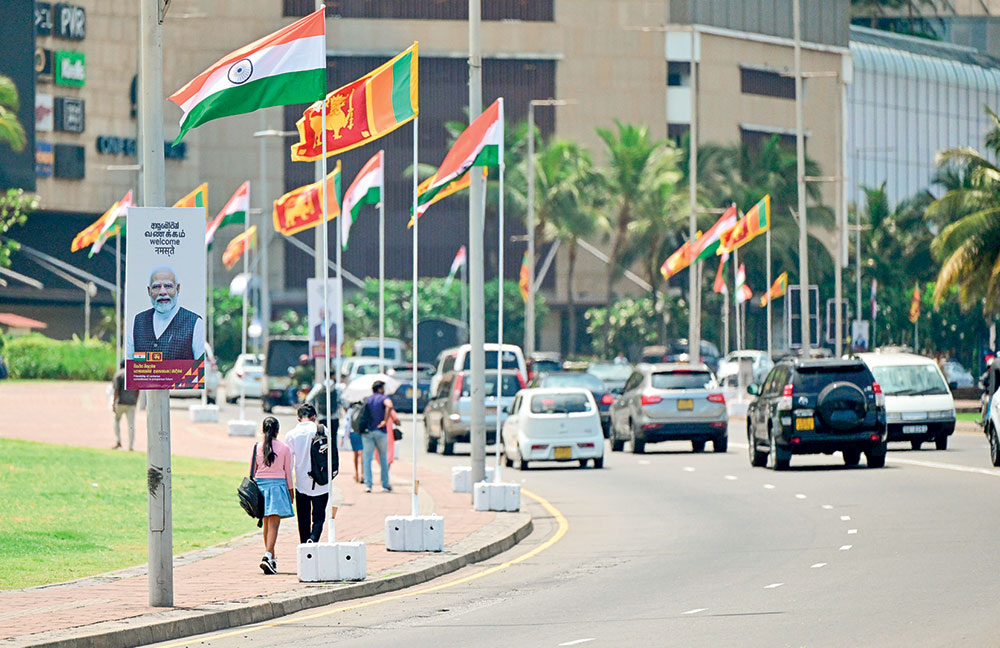
Prime Minister Modi is visiting Sri Lanka this weekend, from Friday, April 4th to Sunday, April 6th. This is Modi’s third official visit as Prime Minister, and the first since Anura Kumara Dissanayake became President and led the NPP to form a new government with a massive electoral victory. The official welcoming ceremony will be at the Independence Square on Saturday April 5th, 54 years to the day after the April 1971 insurrection launched by the JVP, the political progenitor of the present Sri Lankan government. Whether the historical irony of the occasion, if not the underlying coincidence, will be mentioned or memorialized at the official ceremony is unknown at the time of writing to meet the printer’s Friday evening deadline.
Anura Kumara Dissanayake was five years old in 1971 and, if my memory serves me well, Vasudeva Nanyakkara and Mahinda Rajapaksa might be the only living politicians from the 1971 parliament. They were both elected to parliament as young first time MPs in 1970. And quite by coincidence, there will be another wholly nostalgic gathering tomorrow in Colombo to remember Kumar David as comrade, professor and friend. In the 1970s, Vasudeva Nanayakkara, Wickramabahu Karunaratne and Kumar David were young LSSP Turks who were critical of both the JVP and the United Front Government of the SLFP, the LSSP and the Communist Party.
Vasudeva Nanayakkara has the singular distinction of being perhaps the only parliamentarian to be detained by the government both in 1971, in the wake of the first JVP insurrection, and after 1983 that ultimately precipitated the JVP’s second coming. In the now long historical perspective, the JVP campaigned for the United Front parties in the 1970 election and then took guns against them in 1971. The government’s ruthless put-down of the JVP in 1971 created a new template for state repression in Sri Lanka. And to round off the political circle, the 1971 repression helped the UNP to return to power in 1977, free the JVP leaders from jail, and then have its own violent tryst with the JVP in 1988/89. So, history repeated itself, but, pace Marx, both times as fake and both times as tragedy.
The LTTE added a third dimension to this otherwise two dimensional encounters, and by the time it was finished off in 2009, the JVP was emerging as parliamentary political force that at one time another formed governing alliances with the two SLFPs (first in its Horagolla version under Chandrika Kumaratunga and later in its Hambantota version under Mahinda Rajapaksa), as well as the UNP during its atrophying phase under Ranil Wickremesinghe. The Old Left itself, rather what was left of it, divided along the same three ways, and a cluster of them warmed up to JVP’s possibilities under Anura Kumara Dissanayake and his NPP umbrella. Kumar David himself became a prominent testifier for the new JVP/NPP possibilities using his weekly columns in the Sunday Island and the Colombo Telegraph to good effect. Indeed, in the last article he wrote before his passing, Kumar David congratulated Anura Kumara Dissanayake for his magnificent political achievement and expressed cautious optimism for the prospects under an NPP government.
Nostalgia aside, the serious political point here is that it would be a fool’s errand to trace the present JVP/NPP’s political lineage to the embryos of the 1971 or 1988/89 JVP. There is no unmutated political lineage in Sri Lanka. The political circumstances are also wholly different. The political reality over the last several decades has seen multiple scrambling of many eggs, including rotten eggs, to produce different governing omelettes at different times. The one that is obtaining now is a better product than most and one that is without the rotten eggs of the past. So, while there is historical irony in the NPP government’s April 5th official welcome to Prime Minister Modi, it would be incorrect and unproductive to read too much into it.
Trump’s Mad Old World
Far more than domestic realities, there is literally a world of difference in world politics between now and the 1970s. Donald Trump has seen to it this week with his globally sweeping reciprocal tariffs. He has put the planet’s trading system on edge, calling it America’s liberation day. He is not liberating anything, only reverting to the old ways of protectionism an in an insane manner. His forays are a belated assertion of outdated economic idiosyncrasies that he has been harbouring for all his pre-political life when no one took note of him politically speaking.
In the 1970s, Trump was a brash, young, New York upstart. And Modi in India was an RSS activist and made his first larger political mark in organizing protests against Indira Gandhi’s Emergency Rule. He was understudy to the flamboyant George Fernandes, later India’s foreign minister, and a socialist comrade of LSSP exiles in India who contributed their own mite to Mahatma Gandh’s mighty Quit India movement. Now Trump and Modi are at the pinnacles of national power in their respective countries. So is Anura Kumara Dissanayake, much younger and also far more composed and self-controlled.
Trump is unleashing disruption throughout the world, unilaterally upending the postwar world order that was set up under American leadership to oversee global trade and financial transactions. On balance, it has more than served its purpose of stabilizing world capitalism while releasing the human potential and resource endowments of many non-western countries, especially Asian countries, to emerge as robust economies and adding a long needed balance to the lopsided world economy hitherto dominated by the old industrial countries of the west. But these changes by themselves have not weakened the western economies and the European Union and most Americans other than Trump have to come to terms with them in a positive way.
Trump is abhorrent of these changes but not owing to any rational political reasons or objective economic considerations. Those who try to make sense of Trump’s erratic two months in office are beginning to see his obsessive egotistical compulsion to go down in history as America’s greatest president by simultaneously pursuing three unprecedented objectives: physically expand America’s boundaries – to wit his rantings over Panama, Greenland and Canada; make America great again by reverting to the 19th century mechanism of tariffs and dismantling the late 20th century framework of free trade; and by constantly musing about running for a third term in calculated disregard of the clear constitutional provision since 1947 limiting presidents only to two terms in office.
Underlying these pursuits are Trump’s crass racism, his lack of empathy for those who are structurally kept behind in the economy, and his envy towards those and against whom he measures himself and feels culturally inferior. The highs and lows of Trump’s universal tariff structure are reflective more of his biases than of any economic strategy. It is not by accident that Europe and Asia are set apart for special punishment, especially the ASEAN countries, and of course China. Putin’s Russia is not on the list.
At 44%, Sri Lanka is among the 15 worst hit countries in the world, and all of them are countries with small to medium size populations and at varying levels of economic development. At less than USD 3 billion, Sri Lanka’s share of US imports is less than 0.5%, but the US accounts for 23% of Sri Lanka’s exports – the single largest country share. The increased revenue to the US treasury from the increased tariffs on Sri Lankan goods would be less than a drop, while the consequences for Sri Lankan exports, especially the apparel sector, could be potentially disastrous. But there may not be a loss of market for apparel products in the US depending on their current price levels and consumer preferences.
The reciprocal tariff levels are generally 50% of what US has calculated to be the general tariff level against US imports by different countries. But this method of calculation has been criticized because it is based on trade deficit and is not a weighted average of tariffs on individual goods. There is madness even in the method of the Trump Administration. So, for Sri Lanka, the US reciprocal tariff of 44%, and it could be interpreted by a Trump official as generous 50% of the 88% tariff that Sri Lanka is unfairly applying to each imported good from the US. Never mind US imports to Sri Lanka amount to about USD 500 million. At the bottom end of the food chain, Sri Lanka apparently exploits America by a huge trade deficit! The same argument is writ across every country from Canada to China.
By these tokens, India has one of the lower reciprocal tariff levels at 27% in Asia and South Asia, while Bangladesh is slapped with 37% reciprocal tariff and Pakistan with 30%. More importantly, among the larger economies, India is taking a reportedly measured response to Trump’s tariffs as part of its preferred alignment with the Trump Administration. India appears to be keen on avoiding a confrontation with the US, while looking to expand its export mix to the US by taking advantage of the high tariffs imposed on other countries. For example, India is apparently looking to expand its export of electronic goods to US by taking advantage of the high 46% reciprocal tariffs applied to Vietnam which has a well established export sector in electronic goods.
To get back to where I started, Trump’s tariff turbulence bears a more crucial backdrop to Prime Minister Modi’s visit this weekend than the April 5th anniversary that falls on Saturday. Even the set agenda for talks between the Indian Prime Minister and Sri Lanka’s President could be overshadowed by Trump’s announcement of reciprocal tariffs. Not a single country is bent on retaliating to Trump’s tariffs for the sake of retaliation. Every country other than the US is keen to get rid of the tariffs, Trump willing.
The US accounts for 13% of global trade, and if the countries that account for 87% of world trade can deal only with the US without descending into tariff slaps between them, the US will be isolated, and Trump will have to face the wrath of the American consumers hit by rising import prices sooner than now expected. That would be the ultimate way out for the rest of the world from current American madness.
by Rajan Philips
Features
Cardinal vs Mastermind

The Easter Sunday bomb attack on three churches and four hotels on April 21, 2019 that left 269 dead (including 40 foreigners) and wounded about 500 was a day of infamy. It had shattered the peace and tranquility if not also harmony that prevailed from 2009. This was after 30 years of fratricidal conflict (100,000 dead) and 18 months of terrorism (60,000 dead at over 100 a day in a year and a half between 1988-9) had ended.
The agony, grief and pain became boundless when it was discovered that specific actionable operational intelligence received on the April 4, 2019 and thereafter continuously until D Day (Apr. 19) from an undisclosed Indian intelligence agency had been handled with total incompetence and mindless indifference. Despite the said churches and hotels being accurately identified as targets, the crack STF was sent to guard the Indian High Commission where they did a great job!
Into this cataclysmic inferno that had paralyzed all government leaders, stepped Cardinal Malcolm Ranjith. By his words and actions, he prevented any retaliatory attacks in a country with a despicable history of mob violence. He was SL’s hero, honoured, respected and loved by all.
Foreign Intelligence and Investigation agencies including the Federal Bureau of Investigation (FBI), Australian Federal Police (AFP), Internal Security Department of Singapore (ISD), Israeli (Mossad) and of course Indian, investigated the tragedy. They reported back to their governments that all the perpetrators, ideological extremists linked to ISIS, a proscribed global terrorist organization, were dead. Blood relative collaborators of the two families involved, anticipating arrest, had committed suicide in their homes as far apart as Kattankudy and Colombo. Nearly 800 other suspects were arrested of whom more than 700 were either bailed out or released, bringing no credit to the already discredited Police.
Only 25 of them have been charged in court. There was no second wave although scaremongers and instant experts warned that there was a possibility of more attacks. Just to make sure, SL through its heads of missions in USA and Australia, contacted the FBI and AFP respectively. It reassured SL the case was closed.
This wasn’t good enough for some in SL where politically biased rumours are the essence of life. Uttering untruths is mother’s milk to the majority. About two years later certain biased media started creating doubts as to who had ‘organized’ the suicide bombings. Despite the conclusions reached by the world’s best known Intelligence and Investigation agencies (less the KGB that had no immediate interest) even the good Cardinal had been persuaded by discredited state intelligence officers that there was a suspected ‘mastermind’ with a murderous political motive behind the attack.
They had drawn attention to the fact that the dysfunctional government in power was vapourised at the general elections the following year. That this defeat was an obvious consequence to their miserable performance was ignored. No attempt to ask for India’s help was made. Why?
So SL was asked to believe that in its society there existed possibly two barbarians in the mould of Ghengis Khan who could plan and execute mass murder just to take over state power. They played on the inherited and exploited gullibility of the people. It was Goebbels who brilliantly proved that a lie continuously repeated was eventually believed. And there was no TV then. How perfidy thrives.
By coincidence a couple of CID officers too were apparently spreading this very same story about two military officers. That the local government elections a year before the Easter Sunday tragedy, had seen the despised government trounced, appeared to have been conveniently or deliberately forgotten, a national trait. It immediately drew attention away from the guilt of a criminally negligent government and police intelligence. Politicians who had been like mice then, now appeared and joined the chorus.
The Cardinal thereafter never let go. He didn’t think that the FBI, AFP, and other world class Investigation agencies should have the last word. He placed his faith in the informants from the police. Their Intelligence heads and the IGP were found guilty and punished (together with the President) for criminal negligence in the Easter Sunday massacre. He embraced them. The victims were almost all from his Catholic flock. He was fighting for them. He would be relentless and unforgiving to the point of becoming obsessed.
There was a time when defenestration was practiced by the Police. The deaths in 1966 of Sergeant Tilakewardene and Dodampe Mudalai after being thrown from the fourth floor of Police HQ was an example of how ‘evidence’ was obtained. Maybe the Cardinal did not know. Many Catholics however believed he was becoming political. He may have become insensitive to the fact that giving false evidence was an age old tradition. In that SL was world class
There were seven bombers. Four of them were poor radicalized youth led by Zaharan Hashim who even fought the more conservative adherents in Kattankudy with swords. The Colombo three were from a very rich and highly educated family.
The evidence the Cardinal trusted most were the ramblings of one Azad Moulana now seeking asylum in Europe, the involvement of Director Military Intelligence (DMI) and the telephone calls made by the hesitant bomber who left the Taj Samudra hotel and blew himself up in a ‘hotel’ near the Dehiwala Zoo.
According to Moulana, self styled ‘Coordinating Secretary’ to Pillayan and now a self-confessed accomplice to acts of terror thereafter, the Directorate of Military Intelligence (DMI) and Pillayan who was in Batticaloa prison, conspired to brain wash and train Zaharan and three others to murder Christians. The four were being held in the same prison as Pillayan.
The fact that the Director of Military Intelligence (DMI), Maj Gen Suresh Sallay, had been serving at the SL High Commission in Malaysia from 2017 for two years and immediately thereafter one year (2019) in Delhi at the National Defence College (NDC) at the exact time he was supposed to be in SL, appeared to be of no consequence to Moulana and his new ‘accomplices’. They said Gen Sallay had visited SL between tours.
This was supposed to be enough time to visit Batticaloa prison, conspire with four terrorist suspects (who had vandalized a Buddha statue in Mawanella) to kill two policemen on guard duties at Vavanativu, train them in shooting, and store explosives and detonators in Puttalam. Was Gen Sallay training at the College of SL Miracles and not the NDC?
Who is Maj Gen Suresh Sallay? Did the Cardinal know he had been an outstanding officer after initially joining the Infantry (Gemunu Watch). He ended up serving in the Military Intelligence Corps where his intellect, analytical skills, trilingual fluency and excellent writing skills, if not his rugby were assets. He became DMI and was later the first military officer to head the State Intelligence Service (SIS) in a 40-year career. His mother is a Catholic, father a Malay and his wife a Buddhist. Is it the profile of a ‘mastermind’ of a radicalized extremist terror group that the Cardinal and his informants prefer to believe.
Finally, let’s get back to the Taj Samudra hotel bomber who hesitated. He was seen coming out of the hotel without detonating his bomb. He was seen on CCTV talking to someone. That was apparently conclusive evidence that he had a handler who was reporting to a mastermind. He went from there to an obscure ‘hotel’ near the Dehiwala Zoo. Later he was seen going to a mosque for prayers after which he went back to the same ‘hotel’ where he blew himself up, killing two people, not obviously an agreed target.
But what if there is a recording of his conversation? Was it with a woman? Could the woman be his wife? Who else would a suicide bomber listen to and then hesitate to perform? Who else would attempt to dissuade him other than a person who knew she would be a widow soon, if she did not succeed? Can the Cardinal and his informants mull this over?
Is this why the Cardinal has now said he was going to take to the streets? He has said he is unhappy that the government leader who said he would bring the mastermind to face justice has disappointed. The Cardinal would lead protests on the streets. Actually it is the Katunayake highway. His followers would march up and down from Katuneriya to Colombo and back.
Are his informants converts not to the church but to political opportunism? Did they rush to the Cardinal to ask for still more time? Maybe until doomsday? Maybe the very Good Cardinal and his closest lieutenants will now have more time to attend to the church and all his flock instead of bucking the world’s best Intelligence and Investigation agencies and cavorting with imaginary masterminds.
What must not happen is that this endless mistaken media extravaganza does not end in communal disharmony or worse. It has thus far been avoided as the pain that the Catholics endure has been shared by all.
There should also be an apology to Gen Suresh Sallay too. He has conducted himself with dignity and restraint as an officer and gentleman under extreme stress in deference to the Cardinal.
by Zingara
Features
Karu Jayasuriya’s time as Mayor of Colombo:revenue gains and effective administration
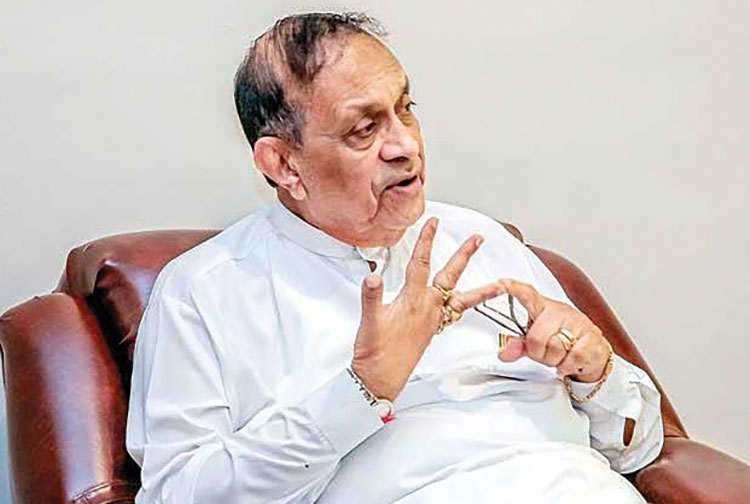
Back stabbing within his own party, CBK keeps to time
During his time as Mayor of Colombo, Karu Jyasuriya had refused to avail himself of benefits and entitlements, opting to spend his own funds for necessary expenditure. These included the monthly allowance, refreshment allowance and fuel allowance allocated to the Mayor. Instead, he ensured that all allocated allowances were routed to the Mayor’s Fund and were utilized for the betterment of the City and its residents.
Karu even declined to accept the official vehicle provided by the Colombo Municipal Council (CMC) and instead used his own vehicle for official Mayoral work. But this did not dissuade opposition members of the CMC from questioning Karu at every council meeting demanding to know details of CMC funds spent by his administration. “What is your monthly fuel allowance?” or “How much did you spend on fuel last month?” were common questions thrown at him.
These questions and jibes by the opposition often made it to the headlines of the government-run ‘Lake House’ newspapers the very next day. The headlines featured were along the lines of “Council member questions Colombo’s Mayor on his fuel allowance…!!” or “CMC members express suspicion that Mayor has secretly increased refreshment allowance in the past months…!!”
According to Karu, despite replying to these unfounded allegations, the rejoinders were not featured prominently in print. “More often than not they were completely ignored by the newspapers…” he says. To his dismay, Karu was to later find out that certain politicians of his own party were behind the acts of these opposition council members. Feeling insecure and threatened by Karu’s rising popularity among the people, these United National Party (UNP) politicians had allegedly bribed several opposition councilors to pose embarrassing questions to the UNP Mayor.
“I heard that sums up to five thousand rupees were paid to ask certain questions. The same tactic was being used to publish them in government-owned Lake House” Karu alleges. He believes this was yet another unfortunate result of the competitive preferential voting system in the country that often pits party colleagues against each other.
But an unruffled Karu had merely continued with his work. In addition to the special committee consisting of councilors, Karu also took steps to form an advisory committee of professionals from various sectors to provide necessary advice and guidance to the administration of the CMC.
According to Karu, these professionals were unpaid and provided their services voluntarily. “Several experts and professionals were also called in to analyze and provide feedback on the CMC and its functions in the hope of receiving constructive criticism…” Karu says.
Housing for the underprivileged in Colombo was also an issue during Karu’s time as mayor. Several families living in Colombo city limits at the time had sought shelter in dilapidated shipping containers due to the lack of adequate housing. As Mayor, Karu had taken steps to construct new houses in Slave Island for these families, allowing them to leave their unsafe shelters behind and move into better housing provided by the city.
At that time Crow Island in Mattakkuliya was notorious as a paradise for criminals such as thieves, bandits and rapists. Shockingly, in just a short period several women had been raped and killed in the area. The gruesome incidents created a sense of fear among people. As Karu recalls, many had expressed their reluctance to travel through the area even during the daytime. Hearing these reports as Mayor, a concerned Karu visited Crow Island. What he saw was that the area was indeed enveloped in a dark and sinister feeling. Determined to change this image Karu directed the CMC to give Crow Island a much-needed face-lift. The result was a much more pleasant and welcoming Crow Island devoid of criminal activities.
According to Karu, by this time many of the roundabouts in Colombo were in a state of neglect. Coming up with an ingenious plan he decided to allow private companies in the area to maintain these roundabouts. “They were expected to beautify and maintain the roundabout allocated to them. The CMC did not pay them but instead, they were allowed to put up promotional signs saying they were maintaining the roundabout. This method was later adopted by many other municipalities of towns across Sri Lanka.
It was also Karu who first introduced high pressure water guns to rid the city of the poster menace. At the time Colombo’s walls and public spaces were covered with promotional posters of politicians, and tuition teachers as well as films and teledramas creating an unsightly scene. Several gangs of thugs had begun putting up these posters for a fee, and fights among them also became a common occurrence.
Karu says as a solution he decided to put up CMC sponsored notice boards on major roads and streets in Colombo for posters and other promotional material to be displayed. Next, he took steps to ban posters on walls and in any other public spaces. But as some groups continued to ignore the CMC’s directives, Karu refusing to back down introduced high pressure water guns dubbed ‘Poster Killers’ by the public to remove any material displayed on any surfaces not allowed by the CMC. Every day after midnight CMC workers would set out to remove posters in the city as directed by the mayor. According to Karu, the poster wars were significantly reduced thereafter.
During his time, Karu says the CMC funded the development and restoration of various places of worship located within the city of Colombo. Funds were provided to all religions with Karu ensuring no particular religion was favoured. One place of worship that benefited through this program was the Thai Temple located in Mattakkuliya, Colombo which was in a state of disrepair at the time.
As Mayor, Karu had also taken steps to renovate the popular Viharamahadevi open-air theatre to provide more space and facilities to hold various types of shows. The Old Town Hall building in Pettah and the Town Hall theatre were other venues that were renovated and modernized during his tenure.
Seeking to further improve facilities available to the public, Karu also observed that many public children’s parks dotting the city of Colombo were in a dilapidated state. He ordered them to be renovated and more facilities added so that children could play safely. The city’s public swimming pool also got a much needed face lift during this time.
According to Karu, the assessment of private properties to levy municipal rates on them, which was a key income stream of the CMC, was in total disarray at the time. “It was discovered that assessment taxes had not been collected for over a decade from many luxury houses in the affluent Cinnamon Gardens area in Colombo while others had only been taxed meagre amounts…” Karu recalls. He says this was a failure on the part of his predecessors who had failed to launch a proper investigation or assessment of the situation.
“The CMC was found to have lost millions of rupees in revenue as a result. I ensured the situation was rectified through the advisory committees and the income of the CMC shot up thereafter…” he says.
Meanwhile, in a bid to further end all corrupt practices and to address any shortcomings of the CMC, Karu decided to introduce a 24-hour investigation unit. The public could inform the newly formed unit of any issues at any time of the day by calling on the hotline introduced.
But Karu was also keen on giving Colombo’s residents the opportunity to approach him directly. To this end, he introduced the phone number 077 771 2345 on which the public could call him directly with any queries or issues faced by them. Karu says he would even receive calls in the middle of the night but took steps to provide immediate solutions to the many problems related to him by Colombo’s citizenry.
One day as Karu was having lunch, he received a call from Prime Minister Sirimavo Bandaranaike. “Karu the street lights in front of my house on Rosmead Place have not been switched off for three days. I saw your phone number in the newspaper and decided to call as I could not stand this waste any longer… she had said. Following the short conversation, Karu called the Municipal Engineer and instructed him to immediately rectify the issue.
While heads of organizations often prefer to hold on to all administrative powers, Karu during his 16-month tenure as Mayor of Colombo attempted to maintain a distribution of his powers instead. “I granted all necessary powers to my deputy Omar Kamil. Meanwhile, the required powers to take necessary action were also granted to the advisory committees headed by Municipal councilors, he recalls.
According to Karu, he was inspired to do so through his own personal experience. “I understood that people tend to work better when they are given the freedom and necessary powers to do so…” he says.
Karu notes therefore he ensured all Municipal Councilors in spite of their political party affiliations received the required administrative powers. “For example, though the UNP held the power of the CMC, I even appointed councilors from the opposition to head numerous standing committees in an attempt to distribute these powers…” Karu says.
It was during his time as Mayor of Colombo that it was announced Prince Charles, the heir to the British throne would visit Sri Lanka to attend the country’s 50th Independence celebrations. Karu engaged in conversation with Prince Charles during this visit and as Mayor of Colombo, was tasked with presenting the ‘Golden Key to the City’ to this Royal visitor.
To discuss the necessary arrangements, the then President, Chandrika Kumaratunga summoned Karu to ‘Temple Trees’ one morning. But with an already scheduled meeting at 10:30 a.m. with the West German ambassador, Karu found himself in an unexpected dilemma. This was because President Kumaratunga was notorious for her lack of punctuality. She would often arrive fashionably late even to official government engagements. Years later Kumaratunga would say this was because she would only move on to a task after finishing the one at hand, often making her late for the next appointment.
“Madam President, I will attend the discussion at 9 a.m. But if you get late I will have to leave as I must keep an already scheduled appointment for 10.30 a.m. with the West German ambassador…” Karu had responded. On the day Karu arrived at Temple Trees several minutes ahead of the 9 a.m. meeting only to be informed that the President was yet to arrive. “I will wait for thirty minutes…” Karu had thought to himself. But to everyone’s surprise, Kumaratunga had hurried in just two minutes past 9 a.m. saying “Karu I am sorry for the delay..!”
“The president was known to get late for hours on end. Some high-level diplomatic visitors were even forced to leave without having met her due to her tardiness. On the day though she was only delayed by two minutes and I was quite surprised that she apologized politely for having kept me waiting for that short time…” Karu says.
While the discussion that followed was cordial, President Kumaratunga had even humbly apologized for the false allegations she had leveled against him during the previous local council election.
During his 16-month tenure as the Mayor of Colombo, Karu believes he was able to serve the people of Colombo and also increase the revenue of the CMC due to his policy of delegating the administrative responsibilities of the Council to work as a team. Karu had only given leadership when necessary and worked towards improving the management of the CMC.
A prime example of this is the ’99 Day Rapid Development Program’ initiated by him. Karu says the program proved more successful than he had initially expected due to the time and effort put in by all staff of the CMC. “We worked on all holidays and weekends during this program…” Karu recalls. Even though senior staffers of the CMC are not entitled to overtime pay and therefore could not be forced to work on holidays, Karu says certain female engineers had chosen to report to work even on holidays during this program despite being pregnant at the time.
Moved by their commitment and dedication Karu was able to later provide these employees with a oneoff allowance for the work carried out during holidays after obtaining permission from the Chief Minister of the Province and the Attorney General after getting a motion passed at a CMC meeting.
Karu recalls the program and the relevant development activities carried out had so impressed the West German Friedrich Naumann Foundation that it led to the program getting international attention.
Perhaps due to his background, Karu had always attempted to carry out many development programs with the assistance of the private sector. This was made easy due to the image he had built over the years as a successful entrepreneur in the private sector. Towards the end of his tenure, Karu had sought to commence a recycling project in the town of Meepe which was to be funded by the Asian Development Bank (ADB). The results of the feasibility study confirmed the project would pose no harm or threat to the environment.
However, politicians of the People’s Alliance representing the areas of Avissawella, Homagama and Maharagama not only voiced their strong opposition to the proposed project but also propagated a negative view about it among residents of the area. As a part of this campaign, all politicians of the Colombo district representing all political parties hoping to contest the then upcoming provincial council elections were called to make a public pledge promising to not allow its implementation if elected. Among those who chose to take this pledge were all the provincial council hopefuls of the UNP. According to Karu, possible environmental impacts of the project had been exaggerated to obtain this result. Karu’s opposition was to no avail. Faced with stiff public opinion from residents of Meepe, the ADB decided to withdraw from the project and commit the funds elsewhere in the region.
At the time a well-known care home for senior citizens in Borella was managed by the CMC. While this institution was home to many elderly women and men, it was no secret that the place was riddled with corruption. Having ordered an investigation into these allegations, Karu discovered that many of them were true. “Some were even profiting off the meals and food items intended for the elderly living in the care home. Even though it was required that healthy and nutritious meals be provided to the residents more often than not the meals were paltry and far from nutritious…” Karu recalls.
He not only put a stop to the corrupt practices, but was also able to obtain the support of various private businesses, the Lions Club and the Rotary Club to organize volunteer programs at the care home. Karu was also able to move the care home to a better fully equipped facility in the town of Battaramulla during his tenure as mayor.
But even as Karu implemented various new plans while working towards the betterment of Colombo’s citizenry, this resulted in a number of UNP stalwarts feeling insecure and threatened by him. Many thought Karu would overshadow them and become more popular among the people. This prompted them to launch a secret campaign against their own colleague. According to Karu, it was this campaign against him that eventually forced him to shift his political career from Colombo to the Gampaha district.
(Excerpted from the biography of Karu Jayasuriya by Nihal Jagathchandra)
-

 Business2 days ago
Business2 days agoStrengthening SDG integration into provincial planning and development process
-

 News6 days ago
News6 days agoBid to include genocide allegation against Sri Lanka in Canada’s school curriculum thwarted
-

 Business1 day ago
Business1 day agoNew SL Sovereign Bonds win foreign investor confidence
-

 Sports3 days ago
Sports3 days agoTo play or not to play is Richmond’s decision
-

 Business1 day ago
Business1 day agoDaraz Sri Lanka ushers in the New Year with 4.4 Avurudu Wasi Pro Max – Sri Lanka’s biggest online Avurudu sale
-

 Latest News5 days ago
Latest News5 days agoIPL 2025: Rookies Ashwani and Rickelton lead Mumbai Indians to first win
-
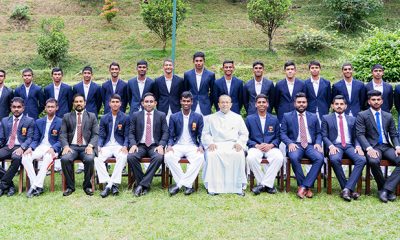
 Sports4 days ago
Sports4 days agoTrinity, St. Anthony’s out to end decade long victory drought
-
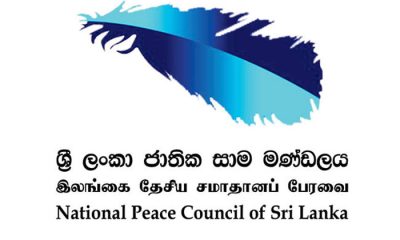
 News6 days ago
News6 days agoSL needs a comprehensive solution, not selective justice: NPC



